What Was It Like When The Cosmic Web Took Shape?
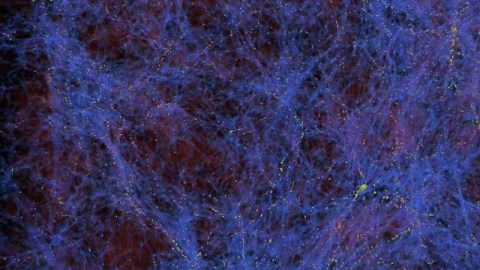
The Universe began almost perfectly uniform, while today, it’s anything but. Here’s how we grew up.
One of the strangest facts about the Universe is how dramatically its changed over time. Today, we see a Universe filled with large galaxies containing hundreds of billions of stars, clumped and clustered together into a massive cosmic web. Closer back in time to the Big Bang, however, everything was extremely smooth and uniform, with very little clumping or clustering to speak of. Go back far enough, in fact, and you won’t find any galaxies or stars at all.
This makes sense from a qualitative point-of-view. The Universe was born with tiny imperfections, gravitation grows them while the Universe expands, and depending on how and where gravity wins, we get these enormous galaxies and galaxy clusters separated by regions containing nothing: cosmic voids. But structure didn’t form all at once, and the largest structures formed last. This is the cosmic reason why.
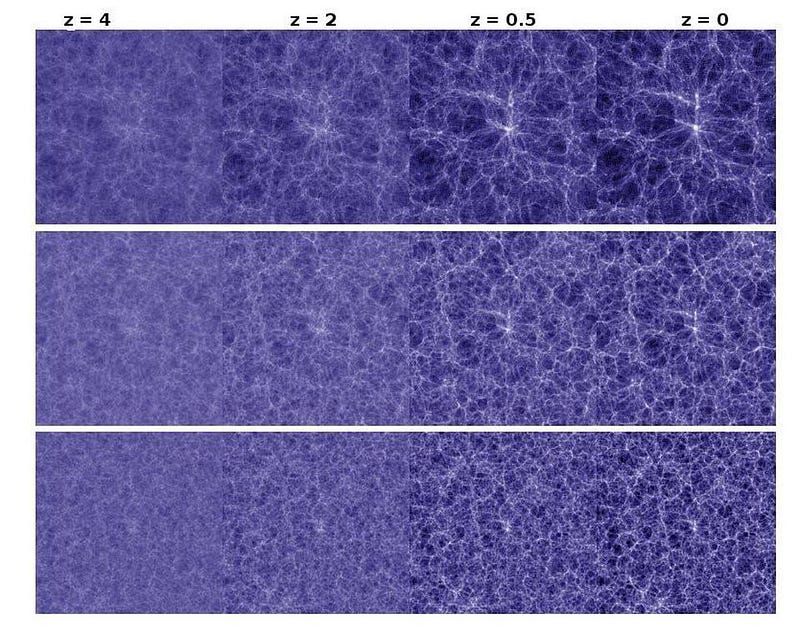
Imagine the Universe as it was in these early stages. It’s full of matter and radiation that distributed almost perfectly evenly everywhere you look. In the aftermath of the Big Bang, a typically overdense region had 100.003% the average density, while a typically underdense one had 99.997% the average density. When we describe the early Universe as uniform, this is the level of uniformity we achieved.
These overdensities and underdensities were almost exactly the same on all scales. Whether you looked at a region a few kilometers or a few light years or a few million or billion light years in size, that same 1-part-in-30,000 fluctuation describes the overdense and underdense regions the Universe began with.
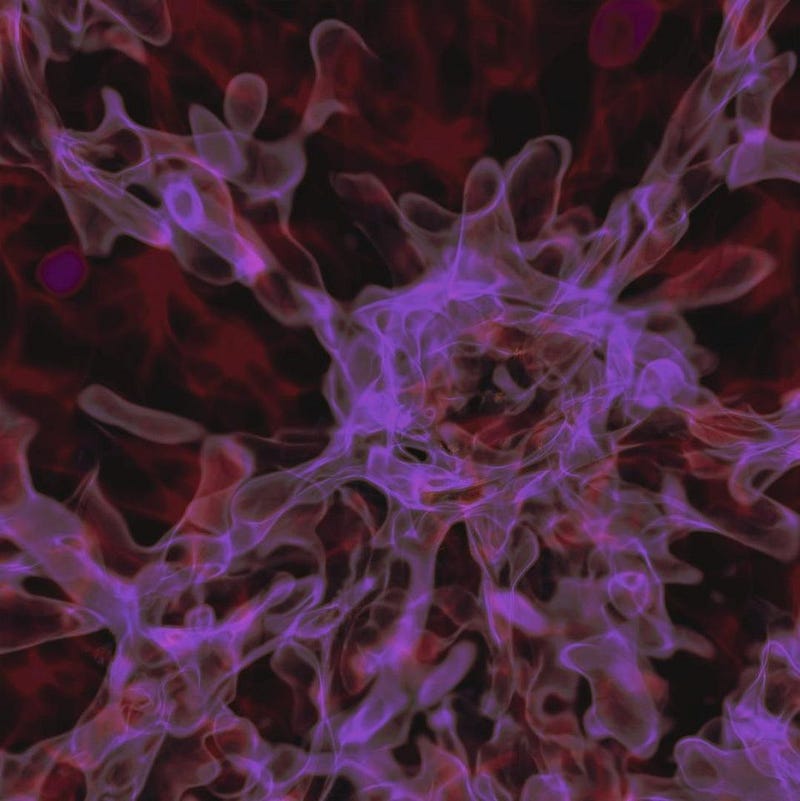
But it doesn’t remain that way for long. Gravity immediately begins preferentially attracting mass into the overdense regions compared to all the others. The underdense regions more readily give up their matter to the surrounding, comparatively more dense regions.
Yet even though the law of gravity is universal, and the same on all scales, the Universe doesn’t form star clusters, galaxies, and galaxy clusters all at once. In fact, it takes under 100 million years for the first stars to form, but billions of years — more than ten times as long — before we form the massive galaxy clusters populating the Universe.
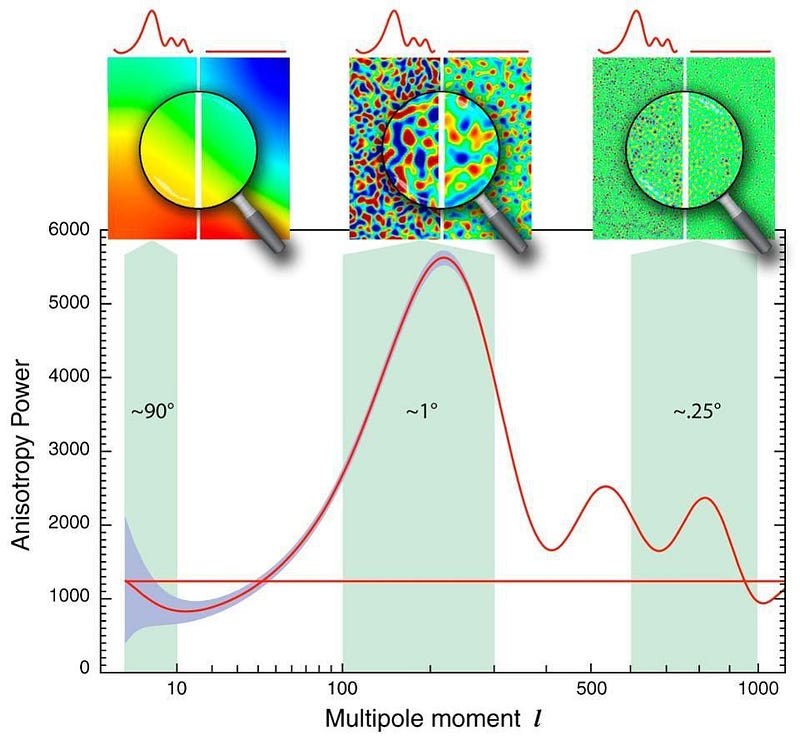
This might seem counterintuitive, but there’s a simple reason for it that shows up in the first picture we have from the infant Universe: gravity is an infinite-range force, but doesn’t propagate at infinite speeds. It propagates only at the speed of light, meaning that if you want to have an impact on a region of space that takes you 100 million years to reach at the speed of light, it cannot feel your presence until 100 million years have passed.
This is why, in the graph of the cosmic microwave background, above, the largest scales (at left) have temperature fluctuations that are completely flat: gravitation hasn’t impacted them yet. That first, massive peak is where gravitational contraction is just taking place now, but there hasn’t been enough collapse to trigger pushback on the part of radiation. And the peaks-and-valleys beyond that represent a splashing around on scales smaller than the current cosmic horizon.
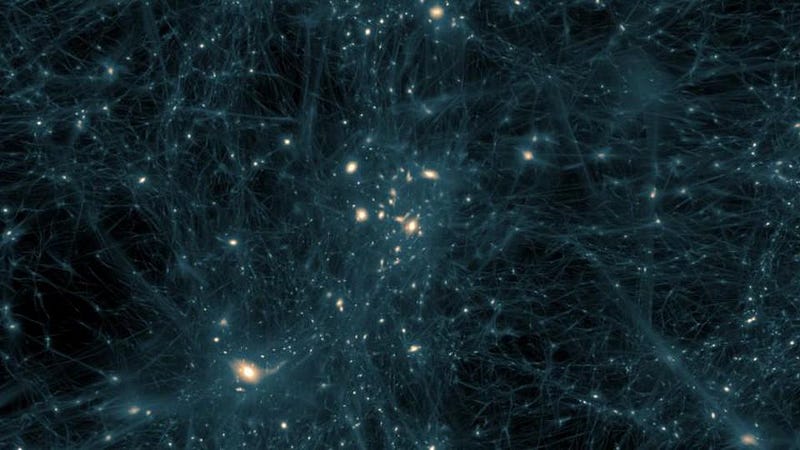
This all translates into a detailed roadmap for how the large-scale structure in the Universe forms. We can break it down into a few general rules.
- Structure will form on smaller scales first: stars before galaxies, galaxies before clusters, clusters before superclusters.
- That characteristic scale where the density fluctuations are the greatest will correspond to a distance scale, today, where we’re more likely to see galaxy correlations than on either shorter or longer scales.
- If there’s some sort of acceleration phase that arises later in the Universe, it will cause a cutoff in structure formation: a maximum, largest scale for structure.
- And once you become gravitationally bound, you should remain gravitationally bound even as the expansion of the Universe continues endlessly.
Based on our observations of the distant Universe, all of these predictions are borne out.
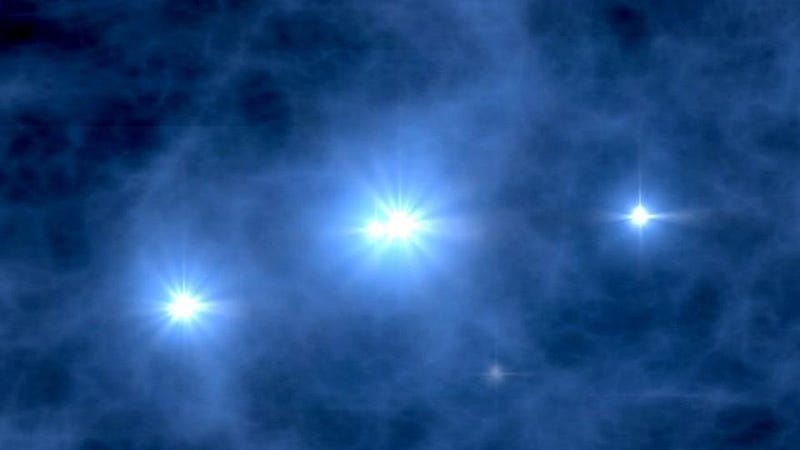
The first stars, as we understand them, appear when the Universe is between 50 and 100 million years old. It takes many millions of solar masses (but under a billion) to initiate gravitational collapse down to stars for the primordial material in the Universe, which means that even the densest regions of all won’t develop stars until many tens of millions of years have passed.
It will take additional time for these individual star clusters to merge together to create galaxies, for those galaxies to merge together to create evolved galaxies and galaxy groups, and for those groups to merge together to form galaxy clusters. This is what we mean when we talk about the cosmic web and the large-scale structure of the Universe: it has to build itself up, from small scales (where gravity takes action first) to large ones.
Even though this is how structure forms in the Universe, giving rise to a network of filaments where clusters exist at the nexuses, the network appears on smaller scales first. The larger scales don’t exhibit structure until the Universe has aged further, owing to the extremely large amount of time it takes a gravitational signal to traverse hundreds of millions or billions of light years.
By the present, we have an observable Universe that’s a whopping ~92 billion light years in diameter. And the scale at which we’re more likely to see these galaxy correlations works out to about 500 million light years, which means if you put your finger down on any galaxy and look a certain distance away, you’re more likely to find another galaxy 500 million light years away than you are 400 or 600 million light years away.
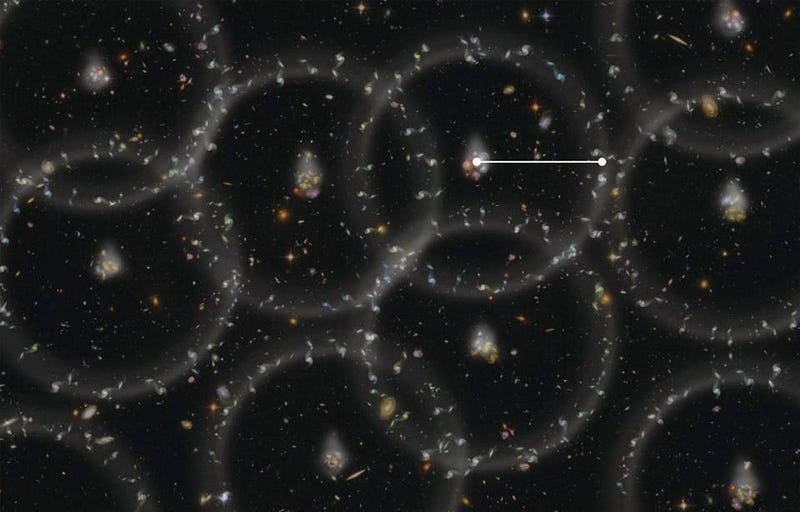
Furthermore, the large-scale features we recognize as galaxy clusters shouldn’t be present at the earliest stages. For many hundreds of millions of years, there should be no galaxy clusters at all, and it should take billions of years to see large collections of galaxies clumping together into bona fide galaxy clusters.
Moreover, the ones that appear at these early times should be lower in mass than the ones that show up later. By and large, this is borne out spectacularly by observations, with the earliest massive galaxy clusters known appearing well after massive galaxies are plentiful. As we look close by, we find galaxy clusters that are more massive and contain far more galaxies than the more distant ones.
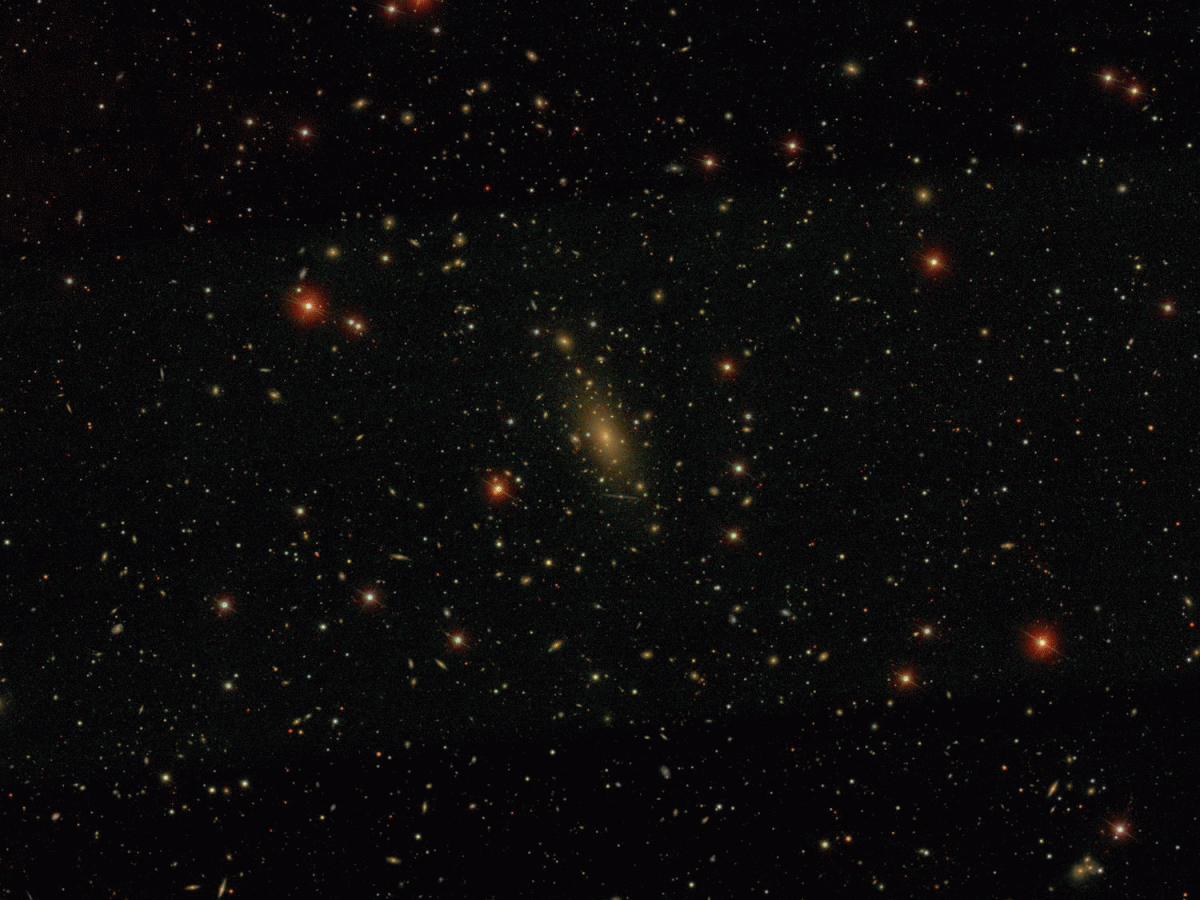
Most spectacularly of all, there seems to be a limit to the size and mass of structures. You may have heard of our local supercluster: Laniakea, which contains the Milky Way, the local group, the Virgo cluster, and many other clusters and groups that appear to be arranged in a spindly, web-like structure. If you were to map it all out, you might be tempted to conclude that Laniakea is real, and that this massive object is an even larger structure than the big galaxy clusters we see across the Universe.
Yet it’s nothing more than a phantasm. Laniakea is only an apparent structure; it isn’t gravitationally bound. On the largest cosmic scales, dark energy dominates the gravitational force, and has been doing so for the past 6 billion years. If an object hadn’t gravitationally grown to a sufficient density so that it would collapse under its own power by then, it never will.
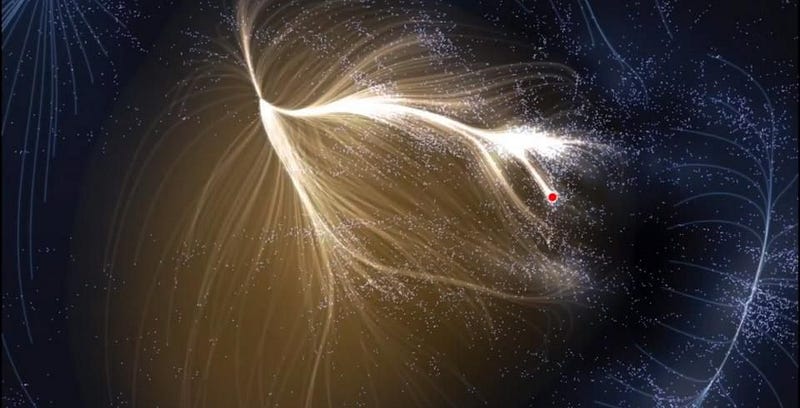
Laniakea, like all enormous supercluster-scale structures, is presently being torn apart by the expansion of the Universe. It takes, on average, about 2-to-3 billion years for these large galaxy clusters to grow to sufficient densities to gravitationally collapse. The most massive ones might contain many thousands of Milky Way-sized galaxies today, but there are no behemoths spanning tens of billions of light years or containing tens of thousands of Milky Ways inside them. The accelerated expansion of the Universe is simply too much for gravitation to overcome.
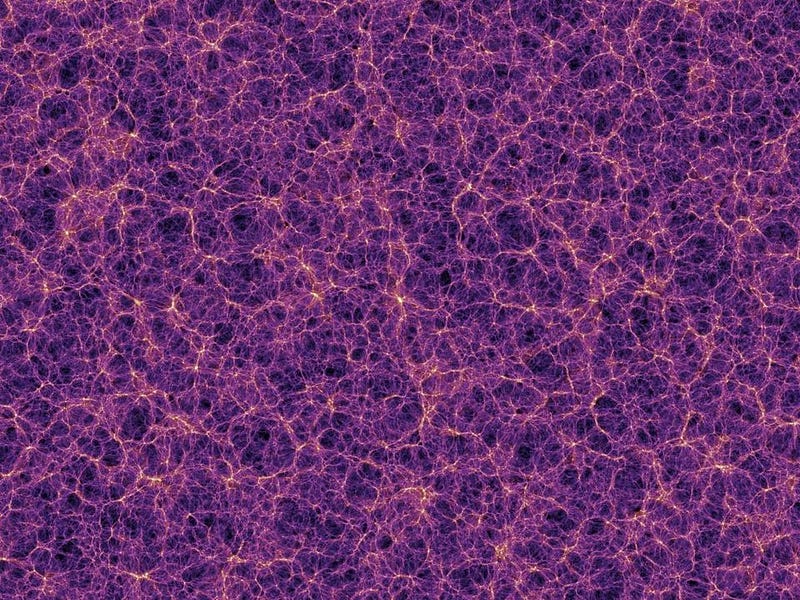
Although the seeds necessary for cosmic structure were planted in the very earliest stages of the Universe, it takes time and the right resources for those seeds to grow to fruition. The seeds for small-scale structure germinate first, as the gravitational force propagates at the speed of light, growing overdense regions into the earliest star clusters after only a few tens of millions of years. As time goes on, the seeds for galaxy-scale structure grow too, taking hundreds of millions of years to bring about galaxies within the Universe.
But galaxy clusters, growing from the same magnitude seeds on larger distance scales, take billions of years. By time the Universe is 7.8 billion years old, the accelerated expansion has taken over, explaining why there are no larger bound structures than galaxy clusters. The cosmic web is no longer growing as it once was, but is primarily being torn apart by dark energy. Enjoy what we have while we have it; the Universe will never be this structured again!
Further reading on what the Universe was like when:
- What was it like when the Universe was inflating?
- What was it like when the Big Bang first began?
- What was it like when the Universe was at its hottest?
- What was it like when the Universe first created more matter than antimatter?
- What was it like when the Higgs gave mass to the Universe?
- What was it like when we first made protons and neutrons?
- What was it like when we lost the last of our antimatter?
- What was it like when the Universe made its first elements?
- What was it like when the Universe first made atoms?
- What was it like when there were no stars in the Universe?
- What was it like when the first stars began illuminating the Universe?
- What was it like when the first stars died?
- What was it like when the Universe made its second generation of stars?
- What was it like when the Universe made the very first galaxies?
- What was it like when starlight first broke through the Universe’s neutral atoms?
- What was it like when the first supermassive black holes formed?
- What was it like when life in the Universe first became possible?
- What was it like when galaxies formed the greatest numbers of stars?
- What was it like when the first habitable planets formed?





